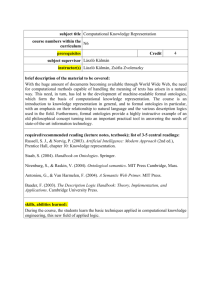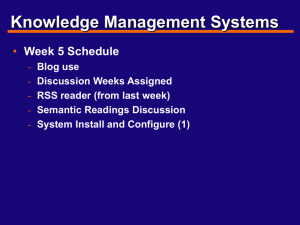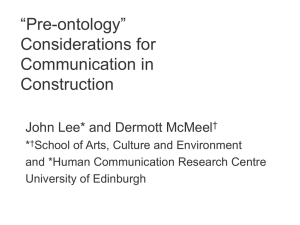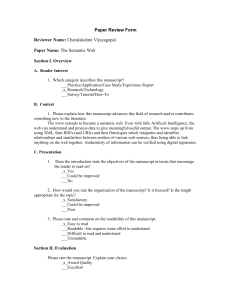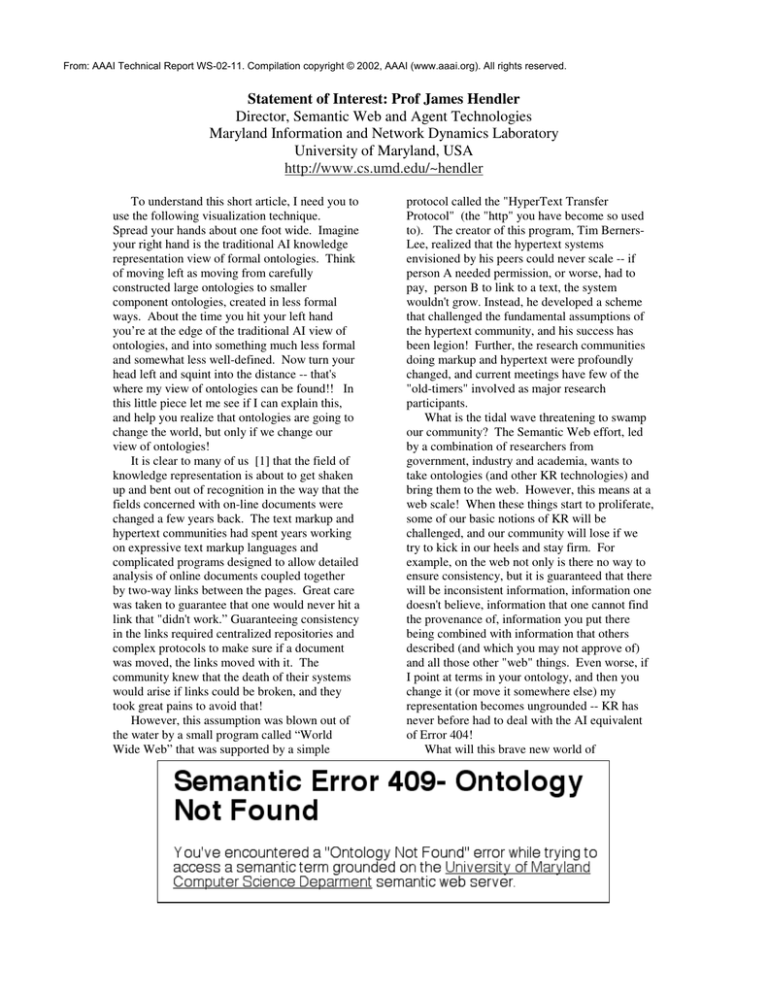
From: AAAI Technical Report WS-02-11. Compilation copyright © 2002, AAAI (www.aaai.org). All rights reserved.
Statement of Interest: Prof James Hendler
Director, Semantic Web and Agent Technologies
Maryland Information and Network Dynamics Laboratory
University of Maryland, USA
http://www.cs.umd.edu/~hendler
To understand this short article, I need you to
use the following visualization technique.
Spread your hands about one foot wide. Imagine
your right hand is the traditional AI knowledge
representation view of formal ontologies. Think
of moving left as moving from carefully
constructed large ontologies to smaller
component ontologies, created in less formal
ways. About the time you hit your left hand
you’re at the edge of the traditional AI view of
ontologies, and into something much less formal
and somewhat less well-defined. Now turn your
head left and squint into the distance -- that's
where my view of ontologies can be found!! In
this little piece let me see if I can explain this,
and help you realize that ontologies are going to
change the world, but only if we change our
view of ontologies!
It is clear to many of us [1] that the field of
knowledge representation is about to get shaken
up and bent out of recognition in the way that the
fields concerned with on-line documents were
changed a few years back. The text markup and
hypertext communities had spent years working
on expressive text markup languages and
complicated programs designed to allow detailed
analysis of online documents coupled together
by two-way links between the pages. Great care
was taken to guarantee that one would never hit a
link that "didn't work.” Guaranteeing consistency
in the links required centralized repositories and
complex protocols to make sure if a document
was moved, the links moved with it. The
community knew that the death of their systems
would arise if links could be broken, and they
took great pains to avoid that!
However, this assumption was blown out of
the water by a small program called “World
Wide Web” that was supported by a simple
protocol called the "HyperText Transfer
Protocol" (the "http" you have become so used
to). The creator of this program, Tim BernersLee, realized that the hypertext systems
envisioned by his peers could never scale -- if
person A needed permission, or worse, had to
pay, person B to link to a text, the system
wouldn't grow. Instead, he developed a scheme
that challenged the fundamental assumptions of
the hypertext community, and his success has
been legion! Further, the research communities
doing markup and hypertext were profoundly
changed, and current meetings have few of the
"old-timers" involved as major research
participants.
What is the tidal wave threatening to swamp
our community? The Semantic Web effort, led
by a combination of researchers from
government, industry and academia, wants to
take ontologies (and other KR technologies) and
bring them to the web. However, this means at a
web scale! When these things start to proliferate,
some of our basic notions of KR will be
challenged, and our community will lose if we
try to kick in our heels and stay firm. For
example, on the web not only is there no way to
ensure consistency, but it is guaranteed that there
will be inconsistent information, information one
doesn't believe, information that one cannot find
the provenance of, information you put there
being combined with information that others
described (and which you may not approve of)
and all those other "web" things. Even worse, if
I point at terms in your ontology, and then you
change it (or move it somewhere else) my
representation becomes ungrounded -- KR has
never before had to deal with the AI equivalent
of Error 404!
What will this brave new world of
ontological information look like? Consider the
current web and the way it works. Documents of
many sizes and shapes are available all over the
place, with some sites developed just to index
others (some of the most popular sites on the
web). These documents are linked in many
different ways, and they refer to things on other
pages with little or no effort required. Web
ontologies will grow in that same way. People
who know that ontologies exist (the “web
masters” of the semantic web) will help define
ontologies for areas of interest to them. These
ontologies will use terms from other ontologies
and so on. In addition, products written for endusers, powered by access to these ontologies,
will also allow for the extension of ontological
terms (for example, a form to be filled out might
have a field called “other” which, when named,
asserts a new property of the class being
extended).
Now, with this in mind, let’s look at ontology
languages. First and foremost, a web ontology
language must be anchored on the web. This
means that each “symbol” must be grounded at a
“universal resource indicator” (URI). Thus, on
the web there is no such thing as a generic
“person” filed, rather one must refer to a
particular definition such as
http://www.cs.umd.edu/projects/plus/personontology.daml #person” which is in turn
anchored to other web locations. This notion of
web embedding is absolutely crucial to the
semantic web, and thus it is a critical property.
On top of the is the ability to relate these
grounded terms one to another. Thus one can
create classes and subclasses, use descriptions or
subsumption, etc. However, it is crucial to keep
in mind that this is the web, and that the web is
huge! No reasoner can work by assuming it
knows everything, has found all possible classes,
etc. without being able to assert what it is closed
with respect to (a particular document or site,
the collection of facts found by a semantic web
crawler, etc.) Further, it is worth remembering
that this is the web – different people will use the
same semantic assertions for different uses, and
thus the exact form of a web language may not
matter as much as the fact that everyone uses it!
I’ll even take that a step further – the
semantic web will not be powered solely by
“reasoning systems,” but by a wide variety of
tools and techniques that use ontologies as their
interlingua. These very different agents will
need to be able to trace terms found on different
pages and find common referents – the content
will be distributed, inconsistent, and preferably
(ready for this?) not very expressive!! On the
web expressivity is the kiss of death – simpler
languages and solutions go further than complex
ones – HTML, a watered down version of the
much more expressive SGML, took over the
world. SGML developers are still wandering
around telling people how everyone else is doing
it wrong, but strangely no one seems to listen.
And that, I believe, is the lesson we in the
KR community must take to heart. Web-based
ontologies are poised to move out to the web and
become embedded in web tools (that is, most
users will not even know they exist as they take
advantage of the ontological content included in
shrink-wrapped programts ranging from
specialized process modeling tools like UMLS to
home page creation tools brought shrinkwrapped over the counter and business-related
applications like spread sheets and word
processors. Note also that AI is already present
in many of these tools, but the users aren’t aware
of it as they mouse the green lines to fix
grammatical errors or use rule-based tax
preparation systems.) When this happens, KR
researchers will have a choice – move with the
times, or become the old ignored grouches
complaining about how the world simply doesn’t
understand what this KR stuff is all about.
Tim Berners-Lee, Jim Hendler and Ora Lassila,
The Semantic Web, Scientific American,
May, 2001.




